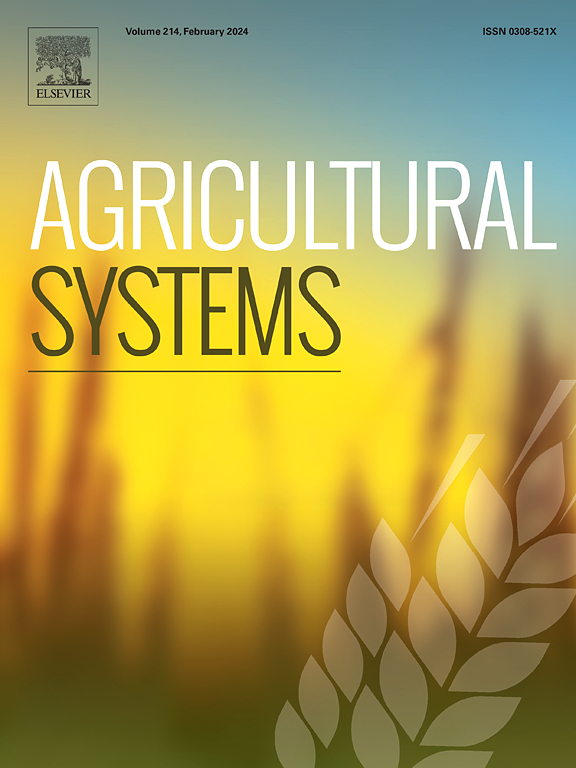Spatial arrangement of action-oriented versus hybrid agri-environmental schemes: implications for the optimisation of grassland ecosystem services
IF 6.1
1区 农林科学
Q1 AGRICULTURE, MULTIDISCIPLINARY
引用次数: 0
Abstract
CONTEXT
The potential of agri-environmental schemes to create synergies among biodiversity conservation and further ecosystem services while accounting for the trade-off with food production is still widely overlooked.
OBJECTIVE
This paper provides a methodological framework to improve the effectiveness of agri-environmental schemes in permanent grasslands at the regional level.
METHODS
The framework comprises three steps that integrate existing approaches to provide decision-makers with a structured and systematic approach for holistic assessments of ecosystem service and guide the spatial targeting of agri-environmental schemes. Step 1 focusses on better understanding the current system and in particular of how agri-environmental measures co-vary with environmental characteristics that are relevant for agricultural production, biodiversity, and further ecosystem services. Step 2 assesses spatial (mis)matches between the current allocation of agri-environmental schemes and ecosystem services hot- and cold-spots. Step 3 focuses on reducing mismatches through a reallocation of agri-environmental schemes.
We illustrated our framework in the canton of Solothurn, Switzerland, to examine how environmental conditions for differently designed agri-environmental schemes (action-based vs. hybrid) and spatial heterogeneity can support synergies between biodiversity and two regulating ecosystem services (climate regulation and pollination) and reduce trade-offs with forage production at the regional level.
RESULTS AND CONCLUSIONS
Our stepwise framework provides a guideline to assess and improve the effectiveness of agri-environmental schemes in grasslands. Each step is methodologically flexible and can be adapted to specific contexts, including the selection of ecosystem services, appropriate indicators, and modelling approaches.
In our case study, extensive grasslands, especially those in hybrid schemes, were predominantly situated on marginal lands, when compared to intensively managed grasslands. Over 90 % of pastures (grazed grasslands) under each of the two agri-environmental schemes overlapped with hotspots of regulating services. Around 15 % of meadows (mown), under each of the two agri-environmental schemes, overlapped with yield hotspots, resulting in considerable trade-offs with food production. 34 % of the grassland area could be set aside for biodiversity conservation instead of being used for (intensive) forage production, as it was located in potential hotspots of regulating ecosystem services and on potential yield coldspots. Pastures under agri-environmental schemes generally showed a better fit with yield coldspots and regulating ecosystem services hotspots than respective meadows. Spatial targeting reduced trade-offs in some cases, but it did not eliminate them, as the focus on specific services reflected local geographical constraints.
SIGNIFICANCE
Our stepwise framework offers insights for the spatial planning of agri-environmental schemes at the regional scale. It serves as a practical tool for spatial planners and decision-makers to enhance the efficiency of environmental management interventions, by supporting the supply of multiple ecosystem services while minimizing trade-offs with agricultural production. The application of the framework suggests that spatial targeting of biodiversity conservation schemes could enhance their effectiveness and reduce trade-offs between regulating and provisioning ecosystem services at the regional scale. Effective reallocation of the schemes should be grounded in environmental contexts that also promote high biodiversity.

行动导向与混合农业环境方案的空间安排:对草地生态系统服务优化的影响
农业环境计划在生物多样性保护和进一步生态系统服务之间创造协同效应,同时考虑到与粮食生产的权衡的潜力仍然被广泛忽视。目的为提高区域一级永久草原农业环境方案的有效性提供一个方法框架。方法该框架包括三个步骤,整合了现有的方法,为决策者提供了一个结构化和系统的方法来全面评估生态系统服务,并指导农业环境方案的空间定位。第1步侧重于更好地了解当前的系统,特别是农业环境措施如何与与农业生产、生物多样性和进一步的生态系统服务相关的环境特征共同变化。步骤2评估当前农业环境方案分配与生态系统服务热点和冷点之间的空间匹配度。第三步侧重于通过重新配置农业环境方案来减少错配。我们在瑞士索洛图恩州展示了我们的框架,以研究不同设计的农业环境方案(行动型与混合型)的环境条件和空间异质性如何支持生物多样性与两种调节生态系统服务(气候调节和授粉)之间的协同作用,并在区域层面上减少与饲料生产的权衡。结果与结论逐步构建的框架可为草原农业环境方案的有效性评价和改进提供指导。每一步在方法上都是灵活的,可以根据具体情况进行调整,包括选择生态系统服务、适当的指标和建模方法。在我们的案例研究中,与集约管理的草原相比,粗放型草原,特别是混合方案中的草原,主要位于边缘土地上。两个农业环境方案下超过90%的牧场(放牧草原)与监管服务热点重叠。在这两种农业环境方案中,每一种方案都有大约15%的草甸(已割草)与产量热点重叠,导致与粮食生产的相当大的权衡。34%的草地面积处于调节生态系统服务的潜在热点和潜在产量冷点,可作为生物多样性保护用地,而不是用于(集约化)饲草生产。不同农业环境方案下的牧场与产量冷点和调节生态系统服务热点的契合度均优于相应的草甸。空间定位在某些情况下减少了权衡,但并没有消除这些权衡,因为侧重于具体服务反映了当地的地理限制。我们的逐步框架为区域尺度上的农业环境方案的空间规划提供了见解。它是空间规划者和决策者提高环境管理干预效率的实用工具,支持多种生态系统服务的供应,同时最大限度地减少与农业生产的权衡。该框架的应用表明,生物多样性保护计划的空间定位可以提高其有效性,并减少区域尺度上调节和提供生态系统服务之间的权衡。这些计划的有效重新分配应以促进高度生物多样性的环境背景为基础。
本文章由计算机程序翻译,如有差异,请以英文原文为准。
求助全文
约1分钟内获得全文
求助全文
来源期刊

Agricultural Systems
农林科学-农业综合
CiteScore
13.30
自引率
7.60%
发文量
174
审稿时长
30 days
期刊介绍:
Agricultural Systems is an international journal that deals with interactions - among the components of agricultural systems, among hierarchical levels of agricultural systems, between agricultural and other land use systems, and between agricultural systems and their natural, social and economic environments.
The scope includes the development and application of systems analysis methodologies in the following areas:
Systems approaches in the sustainable intensification of agriculture; pathways for sustainable intensification; crop-livestock integration; farm-level resource allocation; quantification of benefits and trade-offs at farm to landscape levels; integrative, participatory and dynamic modelling approaches for qualitative and quantitative assessments of agricultural systems and decision making;
The interactions between agricultural and non-agricultural landscapes; the multiple services of agricultural systems; food security and the environment;
Global change and adaptation science; transformational adaptations as driven by changes in climate, policy, values and attitudes influencing the design of farming systems;
Development and application of farming systems design tools and methods for impact, scenario and case study analysis; managing the complexities of dynamic agricultural systems; innovation systems and multi stakeholder arrangements that support or promote change and (or) inform policy decisions.
 求助内容:
求助内容: 应助结果提醒方式:
应助结果提醒方式:


